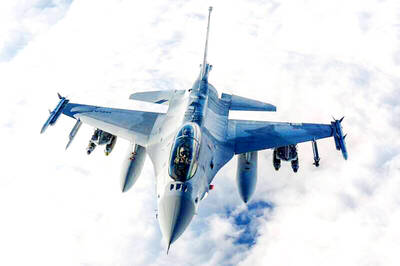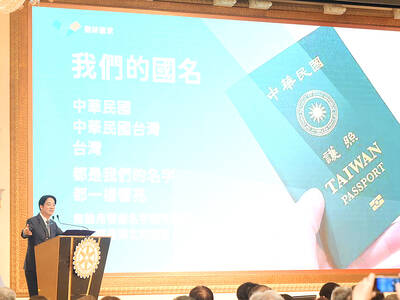The central bank yesterday decided to hike its benchmark interest rates for the 14th straight quarter to curb rising inflationary risks caused by rising energy and raw material costs.
The bank raised the discount rate -- the rate at which local banks borrow short-term funds directly from the central bank -- by another 0.125 percentage points to a six-year high of 3.375 percent effective today.
The rates on accommodations with collateral and without collateral were also hiked to 3.75 percent and 5.625 percent respectively.
"In light of rising energy and raw material prices, the central bank needs to raise key interest rates to stabilize consumer prices and economic growth," central bank Governor Perng Fai-nan (
The central bank forecast that consumer prices would climb at a faster annual pace of 1.8 percent next year, compared with an estimated expansion of 1.74 percent this year.
The latest interest rate hikes would also lead the actual rates closer to "the neutral level," which is a long-term goal set by the bank to stabilize the nation's financial situation, Perng said.
"They have not reached the neutral level yet," he said.
Economists said that after 14 consecutive rate hikes, the central bank might ease up its tight monetary policy next year in line with the global trend.
"If the US Federal Reserve keeps cutting key interest rates next year, Taiwan's actual interest rates may be closer to the US'. This may slow the nation's capital outflow, which is one of the bank's major concerns," said Liang Kuo-yuan (梁國源), president of the private Polaris Research Institute think tank in Taipei.
Liang said relatively lower returns from the domestic stock market and on Taiwanese currency holdings had driven people to invest overseas.
He added, however, that oil prices remain an uncertainty that could influence consumer prices and the bank's decision.
The local currency appreciated NT$0.011 to NT$32.496 against the US dollar yesterday on expectations of a mild interest rate increase.
The nation's economy would grow by a slower 4.53 percent next year, compared with a projected 5.46 percent expansion this year, the Directorate-General of Budget, Accounting and Statistics predicted.
The central bank has also set a target for M2 money supply to expand by between 3 percent and 7 percent next year, compared with a target band of 3.5 percent to 7.5 percent growth this year.

LONG FLIGHT: The jets would be flown by US pilots, with Taiwanese copilots in the two-seat F-16D variant to help familiarize them with the aircraft, the source said The US is expected to fly 10 Lockheed Martin F-16C/D Block 70/72 jets to Taiwan over the coming months to fulfill a long-awaited order of 66 aircraft, a defense official said yesterday. Word that the first batch of the jets would be delivered soon was welcome news to Taiwan, which has become concerned about delays in the delivery of US arms amid rising military tensions with China. Speaking on condition of anonymity, the official said the initial tranche of the nation’s F-16s are rolling off assembly lines in the US and would be flown under their own power to Taiwan by way

FREEDOM OF NAVIGATION: The UK would continue to reinforce ties with Taiwan ‘in a wide range of areas’ as a part of a ‘strong unofficial relationship,’ a paper said The UK plans to conduct more freedom of navigation operations in the Taiwan Strait and the South China Sea, British Secretary of State for Foreign, Commonwealth and Development Affairs David Lammy told the British House of Commons on Tuesday. British Member of Parliament Desmond Swayne said that the Royal Navy’s HMS Spey had passed through the Taiwan Strait “in pursuit of vital international freedom of navigation in the South China Sea.” Swayne asked Lammy whether he agreed that it was “proper and lawful” to do so, and if the UK would continue to carry out similar operations. Lammy replied “yes” to both questions. The

‘OF COURSE A COUNTRY’: The president outlined that Taiwan has all the necessary features of a nation, including citizens, land, government and sovereignty President William Lai (賴清德) discussed the meaning of “nation” during a speech in New Taipei City last night, emphasizing that Taiwan is a country as he condemned China’s misinterpretation of UN Resolution 2758. The speech was the first in a series of 10 that Lai is scheduled to give across Taiwan. It is the responsibility of Taiwanese citizens to stand united to defend their national sovereignty, democracy, liberty, way of life and the future of the next generation, Lai said. This is the most important legacy the people of this era could pass on to future generations, he said. Lai went on to discuss

MISSION: The Indo-Pacific region is ‘the priority theater,’ where the task of deterrence extends across the entire region, including Taiwan, the US Pacific Fleet commander said The US Navy’s “mission of deterrence” in the Indo-Pacific theater applies to Taiwan, Pacific Fleet Commander Admiral Stephen Koehler told the South China Sea Conference on Tuesday. The conference, organized by the Center for Strategic and International Studies (CSIS), is an international platform for senior officials and experts from countries with security interests in the region. “The Pacific Fleet’s mission is to deter aggression across the Western Pacific, together with our allies and partners, and to prevail in combat if necessary, Koehler said in the event’s keynote speech. “That mission of deterrence applies regionwide — including the South China Sea and Taiwan,” he